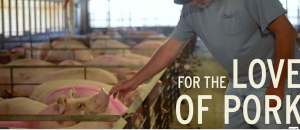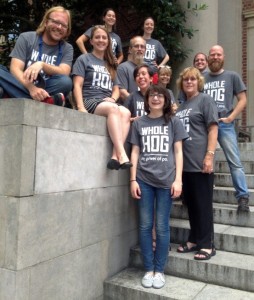Related Posts
| North Carolina is the second largest hog producer in the U.S., right behind Iowa. There are more than 10 million hogs in the state, and every day, they produce 40 million gallons of waste.This waste is stored in massive open-air swine lagoons. The lagoons range from four to 14 feet deep and are lined with clay and feces. As the lagoon fills, the mixture of hog waste and water seeps between grains of soil and creates a sealing effect.The pigs are contained in Concentrated Animal Farming Operations (CAFOs) in close proximity to the lagoon. They stand on a slat – a concrete slab with slits so that feces and urine can fall through to a holding tank. Some systems flush multiple times per day, while others retain waste for up to a week, allowing it to begin decomposition before reaching the lagoon via underground pipes.http://www.elonpendulum.com/2014/04/north-carolina-hog-waste-disposal/ |
Student project on the hog industry
I am not anti-pig, anti-farmer or anti-pig-farmer. I am for quality of life and healthy lives for pigs (and other animals), farms and farmers, and communities. Sometimes, though, those outcomes are at odds when we’re talking hog farming. The clash is not inevitable, and communities and hogs have co-existed in North Carolina for many years.
Even though our state is the second largest hog producer in the U.S. (after Iowa), it’s easy to think of pork as something that comes in neatly wrapped packages at the grocery store. It’s not surprising that the average person driving through eastern North Carolina misses the hog farms; we’re supposed to miss them. We’re not likely to see the 10 million hogs or the 40 million gallons of waste they create every day.
 Our faculty and student researchers in epidemiology and environmental sciences and engineering certainly have given us good data about the detrimental effects of hog farming.
Our faculty and student researchers in epidemiology and environmental sciences and engineering certainly have given us good data about the detrimental effects of hog farming.
And if you’ve gone — as I’ve had the opportunity to do — into communities near industrial hog farms and heard about how exposure to the farms and to hog waste harms people’s health, or smelled the waste while trying to eat lunch at a community meeting near a hog farm, or seen how the penned animals are so close together that they can’t even lie down, you might think twice about how good the industry is for our state.
I don’t have all the answers and sure don’t want to lose North Carolina’s hog farms. But hog farming isn’t synonymous with corporate hog farming.
Check out Whole Hog for some compelling accounts about the industry in N.C.
Powering a Nation, a student-led news team (photo on right) based here at UNC, has released its newest multimedia project Whole Hog.
The project explores energy use and production within the North Carolina hog industry, as well as the industry’s cultural, social, economic and environmental impacts. View the project at www.wholehognc.org.
As the segments show, there aren’t any easy answers, and there’s distrust on all sides. There are more environmentally responsible ways to run this industry than are used today, but they cost more. Who will pay the higher costs? If we continue as we are, who will pay the costs of the effects on human health and our environment? Kudos to the student team for providing information and starting a conversation. We need to keep it going. Although the debates often break down along party lines, it’s much more than that—it’s about a vision for the future of this state, a future in which we can have sustainable agriculture, healthy people and healthy communities. Don’t we all want that?
Happy Monday. Barbara
